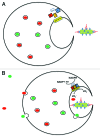An analysis of the structural and functional similarities of insect hemocytes and mammalian phagocytes
- PMID: 23921374
- PMCID: PMC3906293
- DOI: 10.4161/viru.25906
An analysis of the structural and functional similarities of insect hemocytes and mammalian phagocytes
Abstract
The insect immune response demonstrates a number of structural and functional similarities to the innate immune system of mammals. As a result of these conserved features insects have become popular choices for evaluating the virulence of microbial pathogens or for assessing the efficacy of antimicrobial agents and give results which are comparable to those that can be obtained using mammals. Analysis of the cellular component of the insect and mammalian immune systems demonstrates many similarities. Insect hemocytes recognize pathogens and phagocytose material in a similar manner to neutrophils. The killing of ingested microbes is achieved in both cell types by the production of superoxide and by the release of enzymes in the process of degranulation. Insect hemocytes and mammalian neutrophils are sensitive to the same inhibitors. This review highlights the strong similarities between the phagocytic cells of both groups of animals and demonstrates the potential benefits of using selected insects as in vivo screening systems.
Keywords: Galleria; hemocytes; immunity; insect; invertebrate immunity; mini-model; neutrophil; vertebrate immunity.
Figures



References
-
- Pandey JP, Tiwari RK. An Overview of Insect Hemocyte Science and its Future Application in Applied and Biomedical Fields. Amer J Biochem Mol Biol. 2012;2:82–105. doi: 10.3923/ajbmb.2012.82.105. - DOI
Publication types
MeSH terms
Substances
LinkOut - more resources
Full Text Sources
Other Literature Sources
Research Materials
